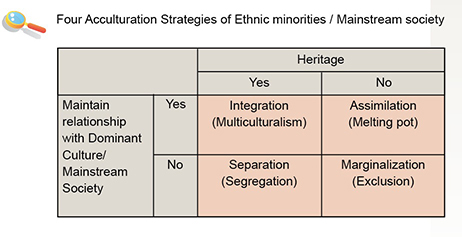| Prejudice and discrimination |
| Prejudice |
- attitudes and beliefs – stereotyping based on a faulty and inflexible generalisation
|
| Discrimination |
|
| Discrimination |
| Direct Discrimination |
- Different treatments - treating a person less favourably under comparable circumstances
|
| Indirect Discrimination |
- Same treatment - impose same requirement / condition on everyone, but some groups are less able to comply with the requirement /condition & will therefore be disadvantaged as a result. Requirement / condition cannot be justified, i.e. not fair & reasonable.
|
| Prejudice and discrimination towards |
| Gender |
- e.g. not employed / promoted due to the gender
|
| Age |
- e.g. elderly with physical deterioration seen as financial burden to family and society
|
| Disability |
- e.g. housing estates do not provide wheelchair access to the residents
|
| Ethnic minorities |
- e.g. employers reject the job application of the ethnic minorities due to language barriers
|
| Patients |
- e.g. employers terminate the employment due to the frequent sick leave of the patients for medical appointment
|
Four Acculturation Strategies of Ethnic Minorities
| Impacts on the health and social care systems |
| Healthcare system - increase medical burden |
- Discrimination leads to the stigma of mental illness. To avoid social isolation, patients may conceal the case history and hinder early diagnosis / treatment that results in a higher risk of relapse
- Discrimination is a stressor leading to strain that affects the mental health of patients and carers, which may also result in mental disorder.
|
| Social care system – increase vulnerability of disadvantaged groups |
- Negative impacts personal development - unsatisfied needs; negative self-image; social and emotional isolation affects different aspects of health
- Persons under discrimination may lack of tight social support network. They may have difficulties in mobilizing individual resources (including personal ability, financial asset and social network etc.) to deal with crisis and become vulnerable groups eventually.
|
| Possible Means and Solutions |
| Individual |
- Avoid discriminatory behaviour / stereotypes
- Learn about people who are different and show empathy and respect for all
|
| Community |
- Healthy settings – community, workplace and school to develop a culture of acceptance
- Provide support services to the vulnerable groups
|
| Society - legislation |
- Disability Discrimination Ordinance
- Sex Discrimination Ordinance
- Family Status Discrimination Ordinance
- Race Discrimination Ordinance
|
Latest Update: October 2019
Power-point
Details See all e-Learning resources
See all e-Learning resources
Tasks & Worksheets (Coming Soon)
Details
| What is discrimination? |
| What are the implications of discrimination to an individual, a family, a community and a society? |
| How can we prevent discrimination at different levels? |
| One Note |  |
|
| Docs |  |
|
| One Drive |  |
|
| Google Drive |  |
|
| Google Sites |  |
|
| schoology |  |
|
| Google Slides |  |
|
| Sway |  |
|








